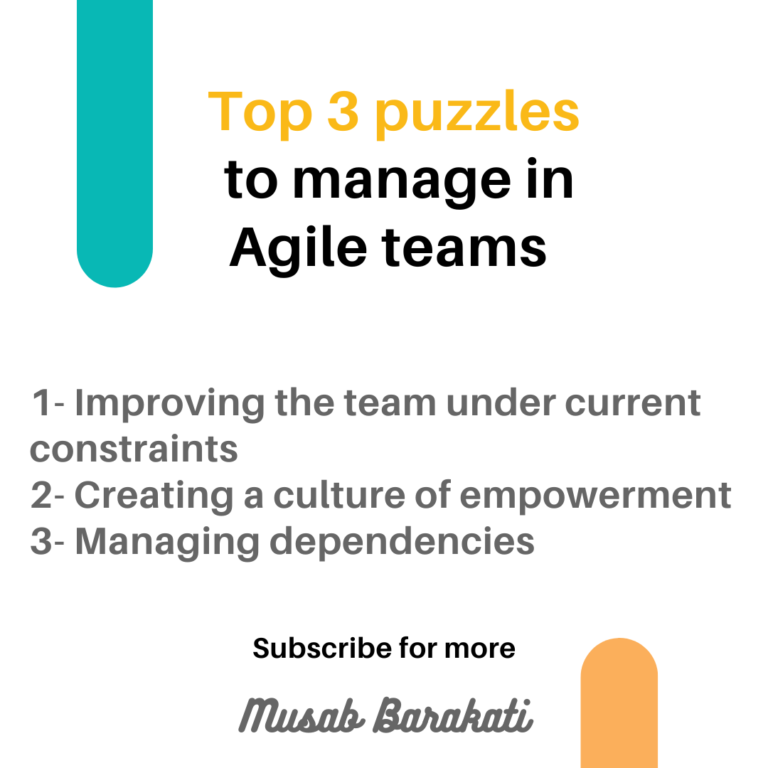Imagine you’re on a treasure hunt team, hunting for hidden riches on a remote island. Your team is small, agile, and always adapting to new challenges. Success depends not just on your skills but also on how well your team collaborates and makes decisions in uncertain situations.
This is a lot like what Agile teams face in the world of modern project management. Agile methods have transformed teamwork, promoting adaptability, innovation, and quick value delivery. However, Agile teams encounter their own unique challenges that require creative solutions.
Today, we’ll explore three common puzzles Agile teams encounter. These challenges demand more than traditional problem-solving; they require Agile thinking, teamwork, and a deep understanding of how to empower teams and manage dependencies. These can be the trickiest puzzles to solve as there are factors outside the team. Let us explore them.


Improving the Team Under Current Constraints:
- Constraint Identification: Start by identifying the specific constraints that are impacting the team’s performance. These could be resource limitations, time constraints, or dependencies on other teams or departments.
- Prioritization: Collaboratively prioritize constraints based on their impact on team performance and the organization’s goals. Use techniques like Impact-Effort Matrix to identify quick wins.
- Continuous Improvement: Implement small, incremental changes to address the identified constraints. Encourage the team to experiment with new processes and tools to find solutions.
Retrospectives: Regularly conduct retrospectives to reflect on what’s working and what’s not. Use this feedback to adjust and refine your approach continuously.

Creating a culture of empowerment:
- Setting the Example: Leadership within the Agile team should lead by example in promoting empowerment. They should exemplify trust in team members and grant them autonomy to make decisions independently.
- Defining Clear Objectives: Ensure that team members have a clear understanding of the overarching goals and objectives. When team members grasp the “why” behind their tasks, they are more inclined to take ownership and initiative.
- Encouraging an Open Feedback Environment: Create a safe and inclusive environment where team members feel encouraged to provide and receive feedback. Emphasize the value of constructive criticism and celebrate achievements and progress.
- Empowering Through Delegation: Delegate decision-making authority to team members whenever feasible. Grant them the freedom to make choices concerning their work approaches, reinforcing a sense of responsibility and autonomy.

Managing Dependencies:
- Dependency Elimination: The initial goal in managing dependencies is to strive for dependency elimination whenever feasible. This involves critically assessing the existing dependencies and exploring ways to restructure teams or redesign the work architecture to remove them altogether. By doing so, teams can operate more independently, reducing reliance on external factors or dependencies.
- Team Restructuring
- Work Architecture Redesign
- Automation: When complete elimination of dependencies isn’t possible, the next best strategy is automation. Automating dependencies entails using technology and tools to streamline and optimize the interactions between dependent components or teams. This reduces the manual effort required and enhances efficiency.
- Manage: While the goal is to eliminate or automate dependencies wherever possible, some dependencies may persist and require ongoing management. These dependencies are typically the most complex and costly in terms of time and effort. To manage them effectively:

In conclusion, Agile teams are adept at solving the puzzles of team performance, empowerment, and dependency management. By embracing Agile principles and applying the strategies discussed, teams can navigate these challenges successfully. Agile is not just a methodology; it’s a mindset that fosters adaptability and continuous improvement. May your Agile journey be marked by innovation and customer satisfaction as you unlock the true potential of your teams.
